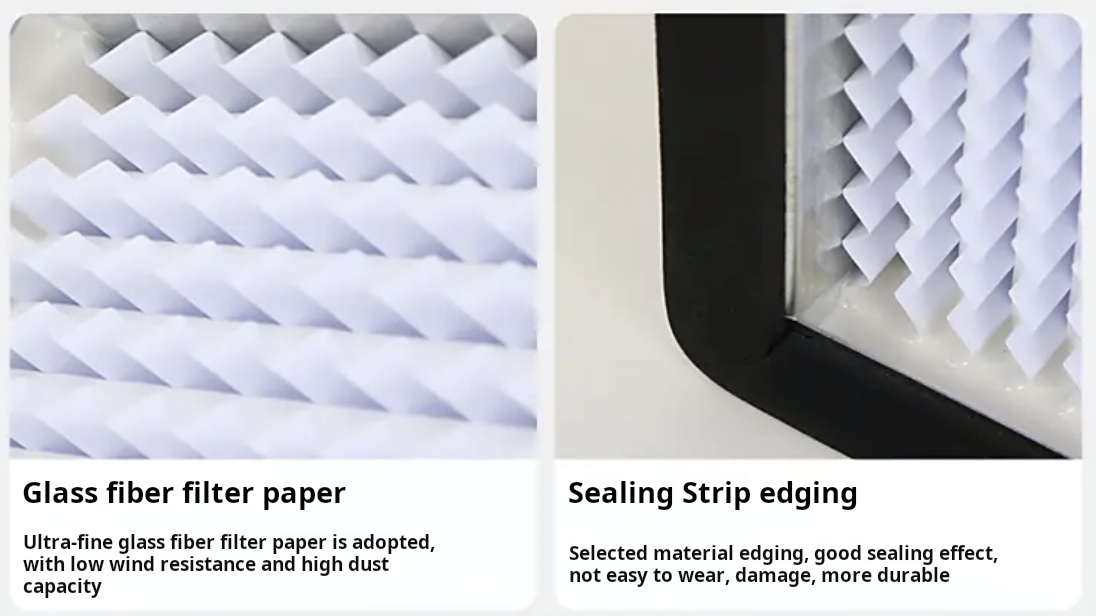hepa (High-Efficiency Particulate Air) filters are widely regarded as one of the most effective methods for removing airborne particles, including dust, pollen, and biological contaminants. However, despite their high efficiency for particulate matter, hepa filters have limitations—they are not designed to eliminate gases or odors. Understanding these limitations is crucial for selecting the right air purification system for specific needs.
hepa filters: What They Are Designed To Remove
Primary Function: Particle Filtration
HEPA filters are engineered to remove at least 99.97% of airborne particles with a size of 0.3 microns or larger, following standards such as EN 1822 and ISO 14644-1. This includes dust, pollen, mold spores, bacteria, and some viruses. The filtration process relies on mechanisms such as interception, impaction, and diFFUsion, effectively trapping particles in the filter media.

HEPA filter structure showing dense fiber matrix
Limitations in Gas and Odor Removal
Despite their efficiency, HEPA filters do not target gases or volatile compounds. Gases like formaldehyde, benzene, and volatile organic compounds (VOCs) are not captured because these are in gaseous form, which HEPA filters are not capable of adsorbing or filtering out.
Why HEPA Filters Cannot Remove Gases and Odors
| Category | Why HEPA Fails to Remove | Supporting Details | Industry Standard/Norms |
|---|---|---|---|
| Gases and Odors | Designed to trap particles, not gases | Gases are too small; molecules typically<0.3 microns | iso 14644-1, EN 1822 |
| Volatile Organic Compounds (VOC) | VOCs are gases emitted by paints, cleaning agents | These molecules are gaseous, not particulate | EPA, OSHA standards |
| Viruses and Bacteria (Size) | Some viruses are smaller than HEPA capture size | Certain viruses are around 0.02 microns; HEPA is not effective for all | CDC, WHO guidelines |
| Toxic and Hazardous Gases | Requires activated charcoal or other media | Cannot be adsorbed with fiber filters | ANSI/ASHRAE Standard 52.2 |
Example: A standard HEPA filter captures particles of 0.3 microns with 99.97% efficiency. However, VOC molecules, like formaldehyde (~0.4 microns), are gaseous and will pass through the HEPA filter unless combined with activated charcoal or other gas-adsorbing media, which are outside HEPA's capabilities.
Additional Limitations of HEPA Filters
- Microorganisms and Pathogens: While many bacteria and larger viruses are captured effectively, smaller viruses or gaseous pathogens are not reliably filtered.
- Gas-Phase Pollutants: Gases such as carbon monoxide or sulfur dioxide are undetectable by HEPA filters and require additional gas-phase filtration systems.
- Odors: Common household or industrial odors (e.g., smoke, cooking smells) are gaseous and not captured by HEPA, necessitating activated carbon filters.
Aligning with ASHRAE 52.2 and OSHA standards, HEPA filters are primarily particle filters and should be complemented with activated carbon or other absorbent filters for comprehensive air purification.

Don't Be Fooled by HEPA Filter Types
While HEPA filters are highly effective at capturing many airborne particles, they have several important limitations that users should understand.
1. Gaseous Contaminants
HEPA filters are designed to capture solid particles, but they do not remove gases or vapors. Substances like volatile organic compounds (VOCs) and odors can pass through a HEPA filter unimpeded.
2. Small Particles Below 0.3 Microns
While HEPA filters are effective at trapping particles of 0.3 microns, they are less efficient for smaller particles, particularly those below 0.1 microns. Nanoparticles may bypass traditional HEPA filtration.
3. Biological Contaminants
Although HEPA filters can capture many biological contaminants, they are not foolproof against all microorganisms. Viruses may not be effectively removed as they can be much smaller than bacteria.
4. Smoke and Fine Particulate Matter
Cigarette smoke and other fine particulate matter pose a significant challenge for HEPA filters. Smoke particles can be extremely small, often less than 0.1 microns.
Relevant Standards and Guidelines
- ASTM F1471 - Standard Test Method for Efficiency of HEPA Filters
- ISO 29463 - International standards for high-efficiency filters
- EN 1822 - European standards for HEPA and ULPA filters
- EPA Guidelines - Recommendations for indoor air quality
What Are the Rules for HEPA Filters?
Definition of HEPA Filters
HEPA filters must meet specific efficiency standards, capturing at least 99.97% of particles that are 0.3 microns in diameter.
Installation Guidelines
HEPA filters should be installed according to the manufacturer's guidelines to function properly.
Maintenance Requirements
Regular maintenance is essential for HEPA filters to perform optimally, including timely replacement.
Do HEPA Filters Really Clean the Air?
| Aspect | Effectiveness |
|---|---|
| Particle Removal | Highly effective for particles ≥0.3 microns |
| Gaseous Pollutants | Not effective |
| Allergens | Significantly reduces common allergens |
| HVAC Integration | Vital for maintaining Clean air in sensitive environments |
What Are the Negatives of HEPA Filters?
- Initial Cost Considerations: HEPA filters tend to be more expensive than standard filters.
- Limited Lifespan: Typically requiring replacement every 6 to 12 months.
- Resistance to Airflow: Can restrict airflow in HVAC systems.
- Not Effective Against All Contaminants: Cannot remove gaseous pollutants or very small particles.
Can Bacteria Grow in a HEPA Filter?
Bacteria can indeed grow on HEPA filters, particularly if they become damp or are not replaced regularly. Moisture can create an environment conducive to microbial growth.
Do HEPA Filters Catch Mold?
HEPA filters are highly effective at capturing mold spores, which typically range from 10 to 30 microns in size. However, they do not prevent mold growth on surfaces.
Conclusion and Summary
In summary, HEPA filters excel at removing airborne particles larger than 0.3 microns but are inherently incapable of removing gases, odors, and certain vapors. For comprehensive air quality management, especially in environments with chemical emissions or odors, combining HEPA filters with activated carbon or other gas-adsorbing media is essential. Deiiang™ offers integrated filtration solutions that incorporate these technologies, designed by expert Deiiang Jason.peng, to meet diverse contamination control needs effectively.
Frequently Asked Questions
Can HEPA filters remove cigarette smoke?
No, because cigarette smoke contains gases and tiny particles that are often smaller than 0.3 microns; activated carbon filters are needed for odors.
Do HEPA filters remove viruses effectively?
Yes, most large viruses or those attached to particles are captured, but some smaller viruses or airborne gaseous pathogens are not reliably removed without added gas-phase filters.
Are HEPA filters effective against VOCs?
No, VOCs are gaseous molecules and require active carbon or other absorbents to be effectively removed.
Can HEPA filters be used alone for chemical allergy treatment?
No, a combination with activated charcoal or other absorbent media is required.
 +86 18186671616
+86 18186671616 Jason@cleanroomequips.com
Jason@cleanroomequips.com
 MENU
MENU


